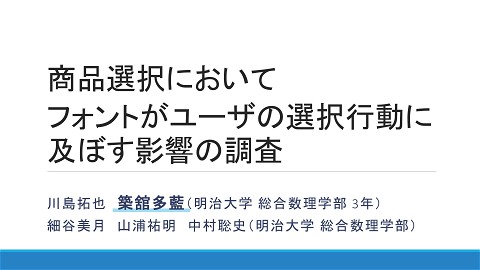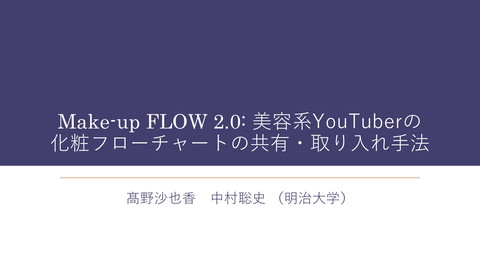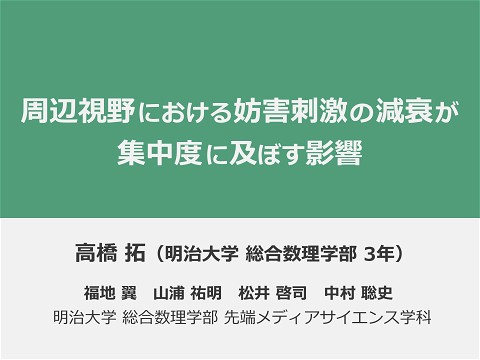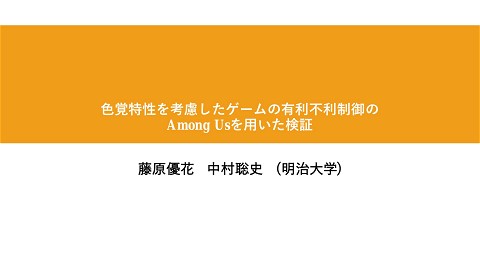Image Blurring Method for Enhancing Digital Content Viewing Experience
457 Views
July 25, 18
スライド概要
HCII2018で使用したスライドです
明治大学 総合数理学部 先端メディアサイエンス学科 中村聡史研究室
関連スライド
各ページのテキスト
Image Blurring Method for Enhancing Digital Content Viewing Experience Hiroaki Yamaura Masayuki Tamura Satoshi Nakamura (Meiji Univ)
Background Many systems have been studied for enhancing viewer’s both experience and interest in digital content. We also would like to realize a method to enhance the viewing experience Enhancing viewing experience
Related Work Low Versatility [Tamura et al. 2015]
Related Work It is troublesome to prepare that many images in advance This system cannot be applied to the arbitrary content Delay interferes with the concentration [Okatani et al. 2009]
Known Problems of Previous Work ‐Low versatility ‐Need to take time and effort ‐Interfering with viewing We have to make a system that easily enhances the digital contents viewing experience
The Purpose of Our Research In order to enhance the viewing experience by overlaying a simple effect on the digital contents No time lag Keep visibility
Characteristics of Vision Central Vision Perceives object clearly Peripheral Vision Perceives surrounding vaguely It may possible to amplify the impression by reproducing the visual field on the display
Our Proposed Method Overlaying the blur effect that follows an user’s eye movement in real-time.
Our Proposed Method Overlaying the blur effect that follows an user’s eye movement in real-time.
Our Proposed Method Original Content
Our Proposed Method Overlaid Content
Our Proposed Method Image of blur effect
Implementation Eye-tracking module - monitors the gaze point of a user using Tobii EyeX, an eye-tracking system - transmits the detected gaze point data to the content presentation module Using GLSL, we suppress a delay Content presentation module - overlays the blur effect on the currently presented content using GLSL - GLSL enables high-speed image processing
Evaluation Experiment (Validation Items) In order to clarify the effectiveness and usefulness of our method Whether... ‐the blur effect amplifies the impression or not ‐visibility is compromised or not
Evaluation Experiment (Procedure) Participants - 8 college students Experimental procedure - We divided 8 participants into 2 groups Each group had 4 participants We asked them to watched videos with blur effect and no blur effect alternately We asked them to answer the questionnaire
Evaluation Experiment (Videos) Videos used We prepared videos of retro video games (2D-Game), new video games (3D-Game), and actual landscapes Retro-Game (2D) New-Game (3D) Landscape
Evaluation Experiment (Questionnaire) Questionnaire detail Emotion(7 items) Relief, Pleasure, Disgust, Excitement, Surprise, Frustration, Interest Psychological impression(4 items) Stereoscopic effect, Immersion, Presence, Tension Physiological impression(3 items) Comfort, Visibility, Concentration
Result (Psychological Impression) 2D-Game : Avg 3D-Game : Avg 2 2 1 1 0 0 -1 -1 -2 -2 stereoscopic effect immersion Without blur presence tension With blur stereoscopic effect immersion Without blur presence tension With blur Landscape : Avg 2 All evaluation values increased or were equal 1 0 -1 -2 stereoscopic effect immersion Without blur presence With blur tension
Result (Physiological Impression) 2D-Game : Avg Comfort Visibility 3D-Game : Avg Concentration Comfort 2 2 1 1 0 0 -1 -1 -2 -2 Discomfort Distraction Obscurity Without blur With blur Landscape : Avg Comfort Visibility Concentration 2 Discomfort Visibility Concentration Distraction Obscurity Without blur With blur Most evaluation values decreased 1 0 -1 -2 Discomfort Obscurity Distraction Without blur With blur The concentration level of Landscape only increased
Result (Summary) The blur effect - increases the psychological impression - decreases the physiological impression - increases the concentration level of Landscape only This system enables to suppress the occurrence of delay - No comment of delay
Consideration Concentration level increased by overlaying the blur effect on the Landscape video Is there a relationship between the gaze and above this? >Dynamically high-resolution part of low-resolution images unconsciously guides the user’s gaze point [Hata et al 2014] Find a relationship by visualizing gaze point log
Heat Map of Gaze Point Log 2D-Game Without blur effect With blur effect There is not much difference between them
Heat Map of Gaze Point Log 3D-Game Without blur effect With blur effect There is not much difference between them
Heat Map of Gaze Point Log Landscape Without blur effect With blur effect Participant’s gaze point tended to concentrate in the center
Consideration By overlaying blur effect on the landscape... - Concentration level got higher - gaze point was focused on the center part Participants can concentrate more on landscape videos by overlaying blur effects.
Conclusion Proposal and implementation of the image blurring method for enhancing viewing experience of digital contents ‐psychological impression increased ‐physiological impression decreased We investigated the influence of the blur effect for users and verified its usefulness and problems
Future Work •When blur is overlaid on the screen while the viewer is actually playing a video game - Is viewing experience enhanced? •Implement effects that focus on the color saturation and lightness





